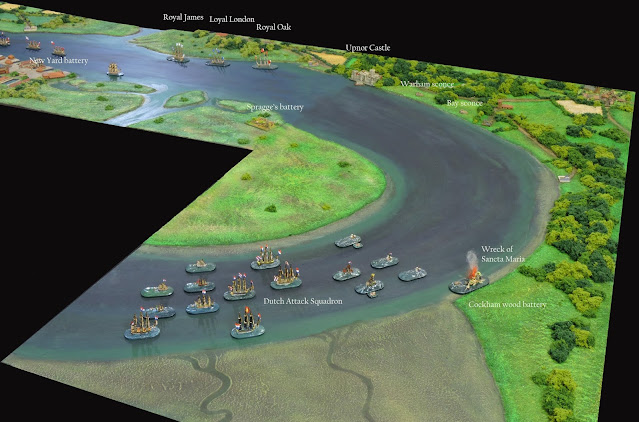The Scenario
This scenario represents the climactic day of the spectacular Dutch attack on the English fleet at anchor in the River Medway. The objective is to burn three large ships of the line which have been partially sunk in shallow water down river of the Royal Dockyard at Chatham. The Dutch are led by the mastermind of the campaign Admiral van Ghent and accompanying the expedition is the Commander in Chief of the fleet Admiral de Ruyter, Vice admiral de Liefde and plenipotentiary of the States General, Cornelis de Witt. The attack has to traverse a difficult stretch of the river, run the gauntlet of English defences and achieve its objective in just over six hours. At that point the tide will turn, sailing in the river will be hazardous and a danger of being grounded in enemy territory is a real possibility.
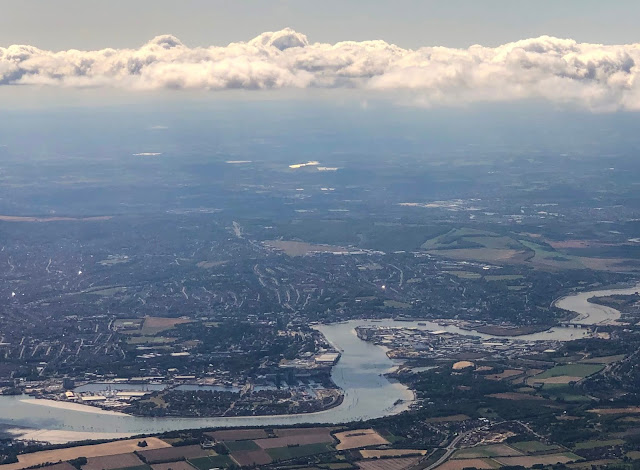 |
| Aerial photo I took of the battle area (start positions in foreground |
Game turns: 25
Victory conditions
The Dutch can claim complete victory if all three English capital ships are set alight. A partial victory is achieved if two are burned. If the English can limit the loss to a single ship and either kill one or more Dutch admiral or critically damage a frigate, the result is a draw. If no ships are burned and Dutch losses are greater than previously stated, English honour is salved. Victory belongs to Albemarle.
| Upnor Castle battle doirama. Picture courtesy of Peter A. |
I have played truncated versions of this battle several times but, this was the first occasion with accurately scaled distances and proper assets. I chose to deploy specifically chosen event cards from Turn 5 onward. Both sides rolled off and the highest score picked from the deck and had to act on it or throw away. The cards were sometimes unfavourable for the winner of the roll off.
| View of the bend in the Medway from Upnor Castle. Picture courtesy of Peter A. |
I knew the first ten to twelve turns would be about navigation and negotiating a long stretch of empty river. The Dutch ships all started from within four inches of the Gillingham river end. This meant arriving in waves – first the yachts and admiral's light craft, then the screening frigates, next the burners and finally, the reserve frigate.
The initial Dutch moves were almost directly into the wind and skill checks had to be passed to move any significant distance. The force soon began to string out as the smaller faster ships raced on leaving a trail of larger vessels behind.
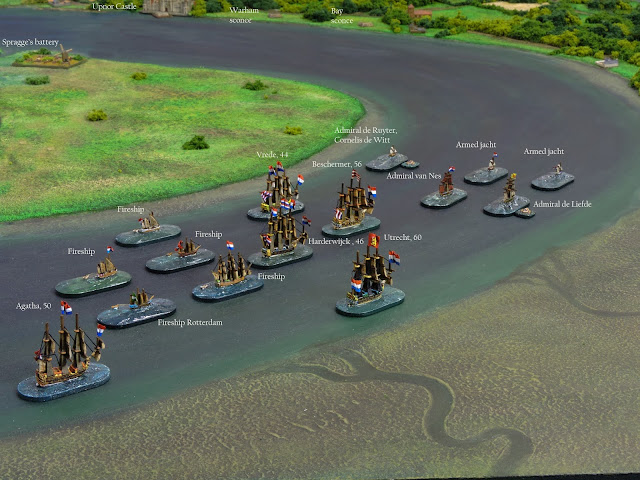 |
| The Dutch attack force. 1/2400 scale. |
Turns 1 to 10
The first incident of note occurred when cards started being chosen on T5. The captain of the English fireship Hound died in a freak accident boarding his craft which was quayside about three miles upriver at Chatham! This was the event card: ‘I am stricken!’
An unexpected piece of what appeared to be good fortune occurred on T8 when the card ‘Monmouth comes!’ signified the appearance of the 70 gun Monmouth sailing from an anchorage near Rochester. As will unfold, Monmouth’s captain would be called before the King in days to come. A small battery was positioned at Cockham Wood Reach and played its fire ineffectually on the passing Dutch convoy across several turns. Range, gun calibre and ability conspired to render its efforts negligible. By T8, the three Dutch admirals’ jachts, sailing well in advance of the attack force, dropped anchor off St Mary’s Island opposite but beyond the range of Bay sconce.
Here they lay awaiting the arrival of their ships. Although the Cockham battery had been blazing away to no effect for several turns, guns at Bay sconce spoke as the first frigate – Beschermer cruised past on T8. Alas, this battery’s fire was no more accurate. By T10 the first damage was inflicted by the dismounted guns of the Old James mounted near Warham sconce just north of Upnor Castle. Some slight damage was inflicted on Harderwijck as she glided by in the central channel. By this time, Beschermer was lying off Upnor Castle. Under the direction of the quorum of admirals, she began the cannonade which was to screen the burners from English fire. Upnor Castle was to endure sustained bombardment from one hundred guns, lasting nearly three hours. This first Dutch fire of the battle was the commencement of that ordeal.
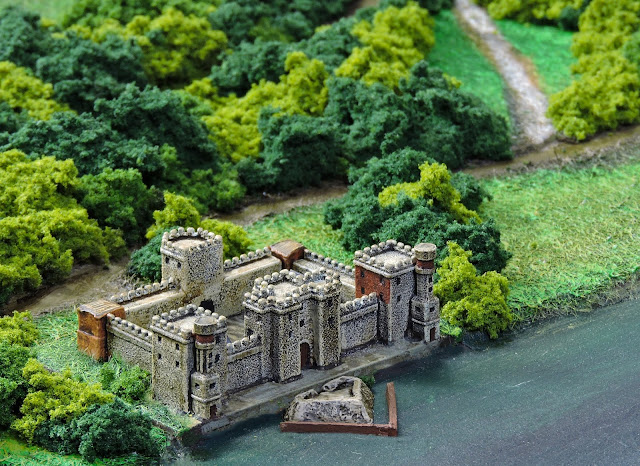 |
| Scene of heavy fighting - Upnor Castle |
Turn 11
The screen of Dutch frigates clustered in the central channel directly before the castle whilst the English guns there, Warham and at Bay, offered ragged fire in response. Harderwijck was the main target of English ire. She received light damage mostly directed from Warham. Sir Edward Spragge in command of heavy guns dragged all the way from The Tower via Gravesend, was positioned in a meadow on St Mary’s Island. Ready to pump shot into the nearest enemy ship Groningen, a ‘Belay your fire!’ card was played upon his battery preventing any action.
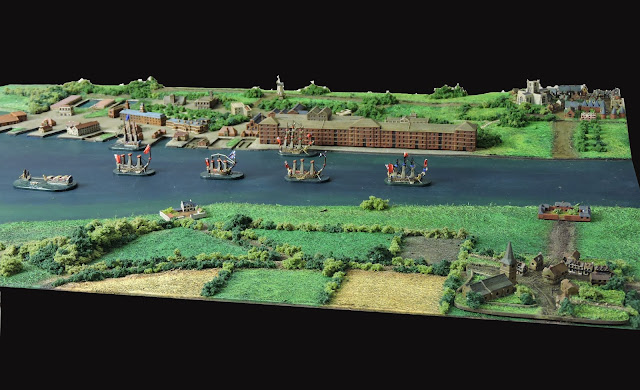 |
| The target: Chatham Dockyard |
Turn 12 -13
As their frigates dropped anchor or nudged into position, the Dutch burners struggled way back down river finding it difficult to navigate the channel. The crew quality of larger Dutch ships allowed them to pass most skill checks and reach Upnor reasonably quickly. The burners were all of Drilled quality and frequently failed sailing skill checks slowing them down significantly. This meant the bombardment had been under way for nearly an hour before the first burner reached Upnor. The castle took heavy fire sustaining six hits. Groningen received light damage from small calibre guns in the castle bastion.
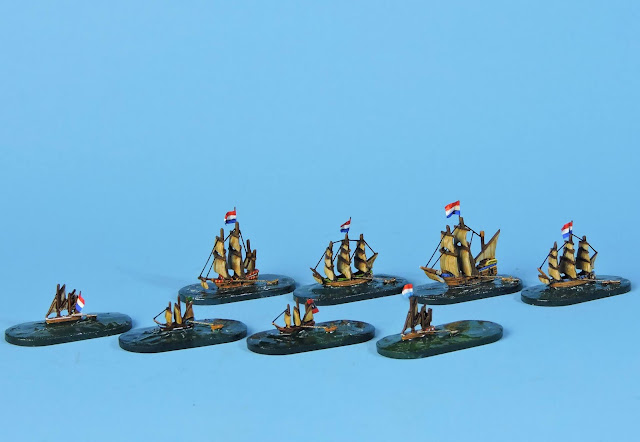 |
| A selection of the Burners I used for the game all 1/2400 (note the crew escape boats) |
Turn 14
The first Dutch burner Gouden Appel came level with Upnor Castle and slipped by behind the solid wall of frigates which reloaded and fired with machine-like efficiency. The English drew the ‘Rousing address!’ card which allowed Spragge to upgrade his heavy gun battery to Veteran. A most useful boost for the hard-pressed English. By now the Dutch backmarker, van Ghent’s river-expedition flagship Agatha, had dropped anchor of Cockham Wood Reach and was engaged in a long-range duel with the shore battery. Hundreds of rounds of ball were expended but few hit the mark from either side.
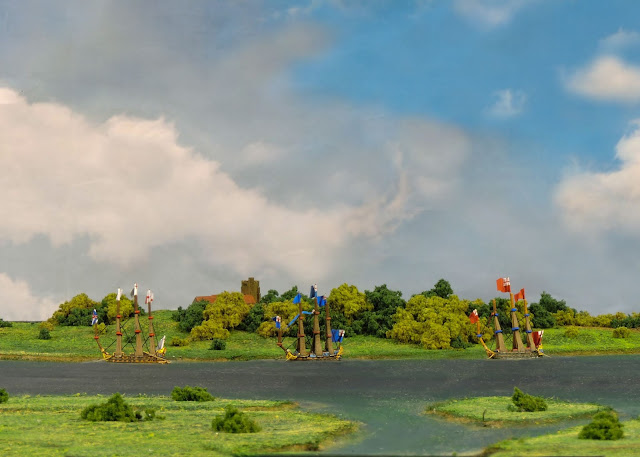 |
| Battleships (left to right) Royal James, Loyal London, Royal Oak |
Turn 15
The ‘Mudbank’ event card was played on the Dutch resulting in the jacht Wilde Gans running aground close to the shore at St Mary’s Island opposite Upnor. The central channel was now severely congested with anchored frigates staying as far out from the bank as possible to avoid English fire, passing burners, jachts and admiral’s personal vessels darting to and fro. Collisions were narrowly avoided several times. As the shape of the Dutch attack developed, English longboats manned by volunteers and soldiers emerged from hidden creeks and assembled in the central channel above the battle at Upnor. Small ships from Chatham docks put out into the river and slowly sailed against the tide and wind towards the smoke-shrouded stretch before the castle. Spragge score the first hit on a passing burner, Rotterdam.

